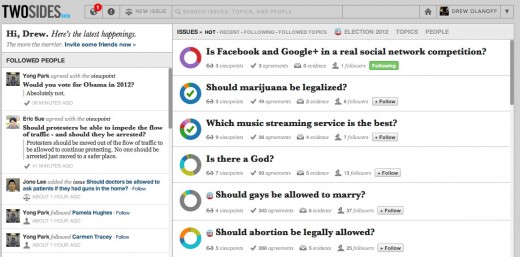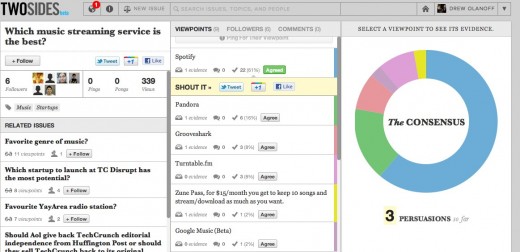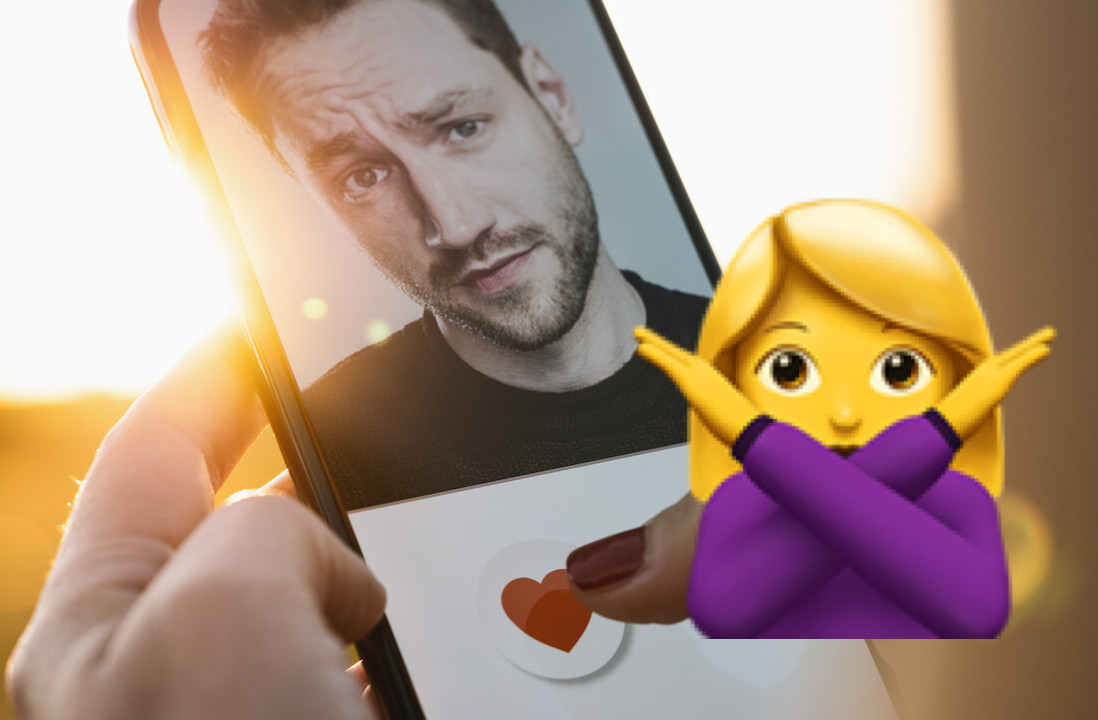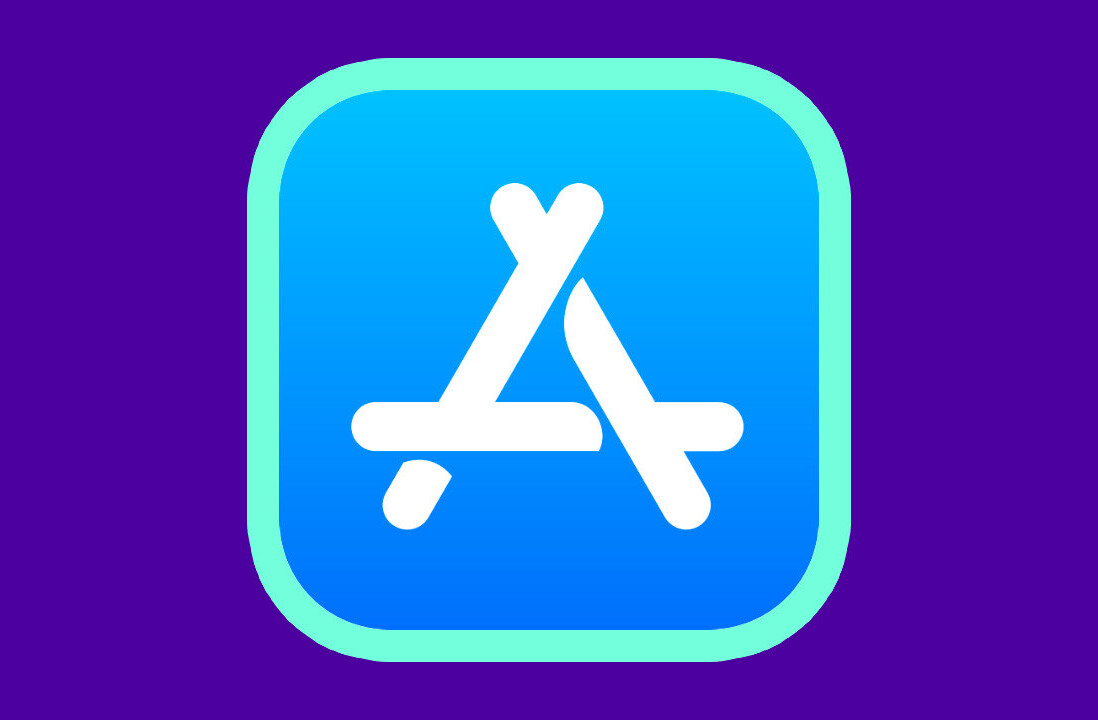
Question and Answer sites like Quora are becoming very popular on the web, and services like Yahoo! Answers has been around for many years.
Sometimes people want to find an answer to a question from real people and not just rely on the results they get in a Google search. A site like Quora allows you to ask a question, and get an answer from a wide variety of people with a wide variety of skillsets and knowledge. As a casual reader, you can vote certain answers up, and a consensus can be drawn based on popular answers, but nothing is definitive.
TwoSides wants to let you add your own question or topic, which the service calls an issue, choose your answer to other issues, add your own question if original authors allow it, and persuade others who don’t agree with your thoughts. You’re then shown a nice graph that updates in real-time with responses. The persuasion system is very interesting. It’s a fairly robust service overall, with a very beautiful design. This is a service that could be very popular during the 2012 elections, since the added feature make the service a great debating platform.
Getting started
Once you sign up for TwoSides, you are shown a list of people you’re following on the left hand side, and their activity. On the right hand side you’re shown a list of active questions with activity, which makes it pretty easy to dive right into the action on TwoSides.
You can click to create an issue, and once you do, you can add the suggested “viewpoints” which are basically answers you’d like people to choose from. You can decide on whether other users can add their own viewpoints, or are limited to the ones you’ve entered.
Once you click into an active issue, you’re shown all of the answers the author has set for you to decide from, and if they choose to, you can add your own viewpoint. Again, this is all fairly simple to understand, and engaging happens quickly. After siding with a viewpoint, you can share the issue on Twitter, Facebook, or Google+ respectively. This will help create a network effect around hot issues and build engagement for TwoSides. You can also “persuade” others to change their argument. This makes TwoSides stand out where other QA sites fall flat. It’s way more interactive, and you get points if you successfully persuade someone to change their viewpoint during lively debates.
Standards of participating
TwoSides does a great job of stating its suggested standards of participating on TwoSides. The company makes it clear that the company would like to have non-flaming, and well thought out questions, responses, and arguments, as shown by its standard pop-ups that show before you’re allowed to post anything to the service.
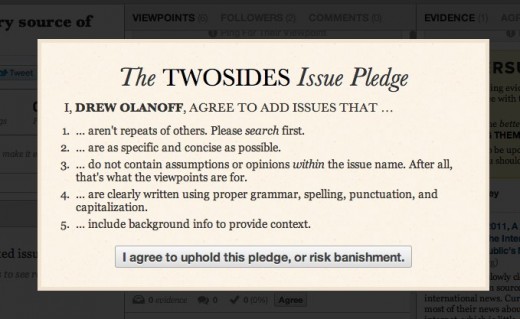
Why TwoSides?
The Next Web had a chance to interview Jono Lee, founder of TwoSides about the new service, which is still in beta.
TNW: What made you want to start TwoSides?
Jono Lee: When I became 18 and started voting, I wanted to know what I was voting for. However, I was appalled by how hard it was to find balanced information. Googling took way too long, television networks were always biased, and articles often just told one side of the story. If it took someone as motivated as me hours to find balanced information on one proposition, what about everyone else?
After doing a bit of research I realized everyone was having this problem. For example, 9 out of 10 voters in the last midterm election felt they encountered information that was misleading. It’s not just politics though. A more everyday example was that in order to find the best 5 day workout plan, my friend had to wade through 30 pages and 7 years worth of information on a workout forum. However, the chronological format made the information hard to parse and digest.
TNW: Who are your competitors, and how is your service different?
Jono Lee: There have always been attempt at debate sites in the past, but none that have been executed that well. There is also some definite overlap with the Q&A space, such as Quora. However, ultimately our biggest competition is the old way of doing things. Inertia requires a significant amount of missionary selling and thus we find ourselves competing less with companies offering a similar solution and more with changing users’ behavior, mainly how to show them that there are better ways to find balanced information than wading through pages and pages of search results or forums.
TNW: You appear to have standards to posting, is the Community abiding by those standards so far?
Although hard to quantify, from what I can tell there’s definitely been less crappy content after we instituted those “pledges.”
TNW: What does standards do for a site like TwoSides?
Jono Lee: TwoSides, like many other sites today, is about all user generated and curated content. Without some sort of standard for that content, it would just devolve into mindless dribble and be of no use to anyone.
TNW: How important are sites like Twitter, Facebook and Google+ for growing the userbase and engagement for a site like TwoSides
Jono Lee: Hugely important. It would be dumb of us to not utilize these viral channels to distribute ourselves through. Also, the issues on TwoSides are usually pretty controversial and can spark some great conversations, so it’s the perfect use case.
TwoSides sounds like a huge undertaking, and it will definitely take some time to pick up traction. Luckily, the service is easy to get started on, and the issues and viewpoints are the most important part, which will serve TwoSides well, as it has highlighted them beautifully.
Jono Lee tell us why TwoSides has a shot in this space:
Because the world would be a more open minded and tolerant place if everyone looked at every side of an issue. And because you don’t know what you don’t know.
Get the TNW newsletter
Get the most important tech news in your inbox each week.
